Surfing can be associated with many injuries such as cuts, bruises, and head crashes. The most common injury is knee joint pain, which is called the surfer’s knee pain. It is very painful and involves the tissue and muscle surrounding the knees.
So, is surfing bad for your knees? Surfing can be very wearing on the knees and cause pain. Surfer’s knee pain is a term given to knee pain caused by surfing. After a significant amount of time surfing, the tissues surrounding the knee tend to wear down. This is mainly caused by surfers not properly rotating their body movements and putting most of the force onto their knees.
Injuries to the knees do not always come from the obvious wipe-out or impact forces. These injuries cause strain on the knee and significant pain, but are not the only reasons for knee pain that surfers come across.

How Surfing Affects Your Knees
Surfing is actually full of more injuries than most people think with knee injury being the most common. It is seen mostly after surfing for a long time and using the knees more often than rotating all body movements. It wears down the tissue surrounding the knees over time.
Surfing can take a toll on your knees. So much in fact, that there is a term called the surfer’s knee pain. Surfer’s knee can be very painful and make it even harder to surf.
The knee joint has tissue surrounding it and the quality of this tissue greatly impacts the knee’s movement. In a bad state, it can cause terrible pain. The pain will start in the muscle and spread to the tissues and then to the knee joint.
One technique which can lead to knee pain in surfers is when caving the back knee inward, causing tissue degeneration. It is not something that can be changed and is pretty detrimental to good surfing, but it does put stress on the inside of the knee. The knee here does not have as much muscular support and more expectation on the ligaments causes it to have to stabilize your knee.
While a surfer is standing on the board, they tend to rotate their hips back toward the foot, while their torso is rotated toward the front foot, which can cause immense strain on the knee. Of course, this is reversed depending on the footing used. Over time, this causes imbalanced loading through the hips, knees, spine, and ankles.
Some knee injuries can be avoided by knowing how to avoid a few things and how to do some others. If you feel a bit of an ache after surfing, you may need to work on how you move to avoid injury.
Don’t Rotate Through Your Knees
It is crucial for the health of your knees, that you allow for a range of motion and stability across many joints. Avoid using a specific movement pattern so that your knees do not feel the brunt of the force. If your knees are sore, you won’t be able to produce as powerful of moves as you would have been able to otherwise.
As a surfer, it is very important to have healthy knee joints and strength of muscles, hips, and legs. While surging, you may put your body in many unnatural positions which puts a strain on your knee joints. Do not rely on just your knees to produce the force you need while surfing, as it can cause serious knee pain.
Above Your Knees
As you turn through the waves, try to use your entire body. To help your knees, try rotating through your trunk and shoulders. Moving between turns works best while leading with your shoulder and hips.
Flexibility between hip, knee, and ankles will help with staying low and balanced while riding the tube. Rotating your movements will stop you from using just your knees to compensate for the force needed to turn. Just this small amount of change can take large amounts of strain off of your knees.
Stretches To Prevent Injuries While Surfing
The single best advice one can give regarding the health of your tissues and muscles, is to stretch before surfing. Stretch certain intended muscle groups as well. It is always a good idea to stretch your hips and do a few exercises before the immense workout you are about to have on the waves.
Adequate hip and ankle mobility and a strong torso is vital. When these things are not working well together, your knees will most likely feel the pain. Stretching each of these and working them out will help in the long run.
Stretching and strengthening exercises can help with pain and also improve range of motion and flexibility. These exercises can reduce stress on your knees and help to move with more ease. Below are some gentle stretching exercises you can do before and after surfing. You can do these exercises as often as you feel necessary.
Always consult with your doctor, and if you feel you may have a serious injury, call your doctor right away. Your doctor may need to perform tests to rule out any injuries. It is a good idea to always check with your doctor before starting any exercise plan.
Heel And Calf Stretch
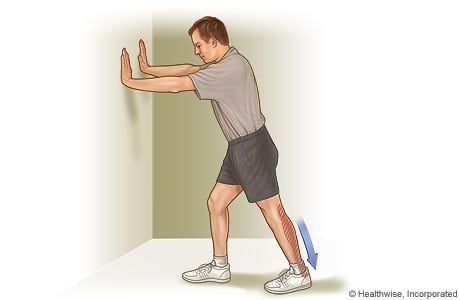
Stretching in this way helps to target your muscles in your lower leg.
- Stand facing a flat surface
- With your hands on the flat surface, move one foot back as far as you can without straining your muscles. Both feet should be facing forward with flat heels and a slight bend to your knees.
- Hold for 30 seconds while leaning into the stretch. You should be feeling the stretch in the back of your leg.
- Switch legs and repeat.
- Repeat this stretch twice for each leg.
Quadriceps Stretch
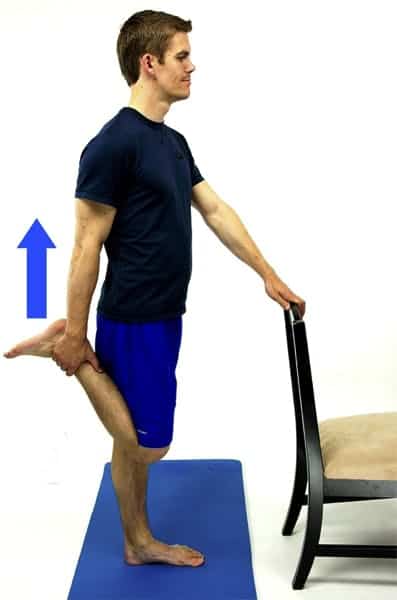
The muscles at the front of your thighs are called the quadriceps. This exercise specifically targets this area and can help improve your flexibility in your quadricep muscles and your hip flexors.
- Stand against a flat surface like a wall or you can use a chair for support.
- Bring your feet shoulder width apart.
- Bend your knee backwards so that it is up toward your glutes.
- Hold your ankle and pull gently toward your glutes as far as you can.
- Hold this position for 30 seconds.
- Place your foot in the starting position again and switch legs.
- Repeat twice for each leg.
Hamstring Stretch
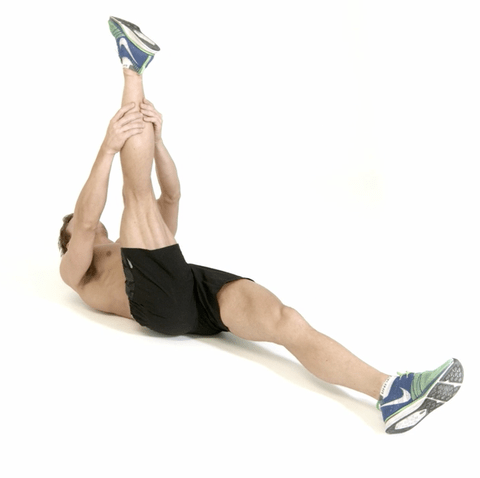
Muscles at the back of your thigh are your hamstrings. This stretch focuses on your hamstrings. Stretching this way, you will feel it in the base of your glutes and the back of your leg.
- This stretch will be lying on the floor. You may want to get a mat to add a little bit of cushion under your back.
- Lie down on the floor and place both legs in a straight position.
- Lift one leg up off of the floor.
- Placing your hands behind your thigh, pull your knee toward your chest until you can feel a stretch. It should not cause pain.
- Hold position for 30 seconds.
- Lower your leg back to starting position and switch legs.
- Repeat stretching twice for each leg.
Prone Straight Leg Raises
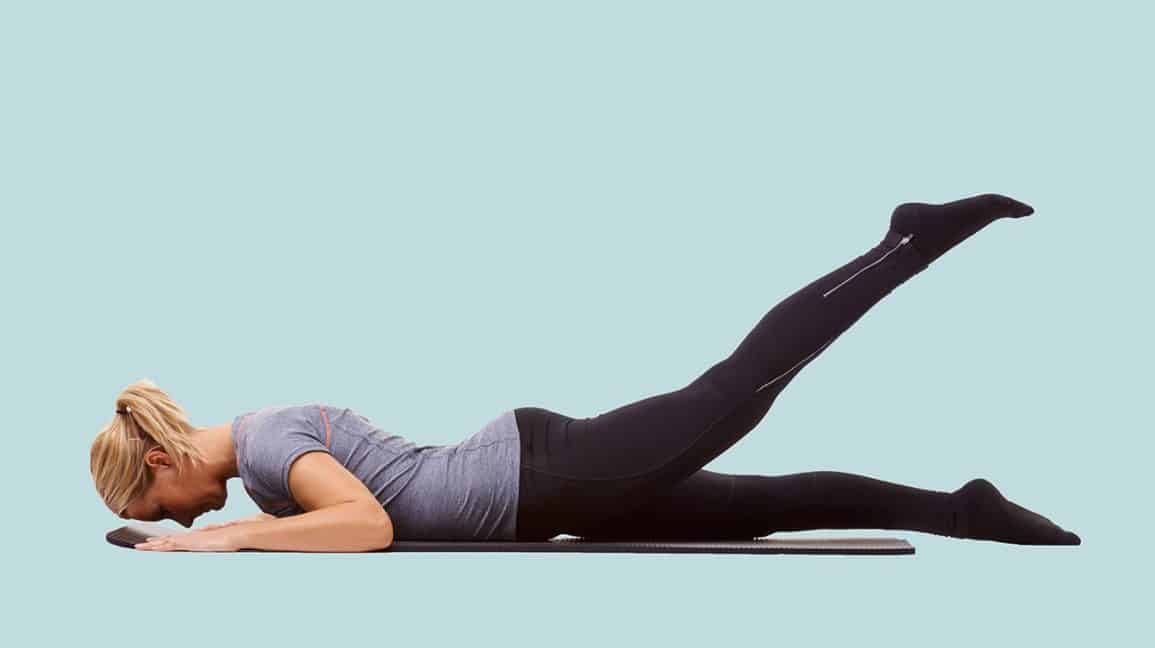
Adding ankle weights to this exercise is a great way to strengthen the muscles. You should never feel back pain and if you do, limit how high you try to lift your leg.
- This stretch will also be lying on the floor. You may want to use a mat to add a little cushion for your back.
- Lie on your stomach keeping your legs straight.
- Tightening the muscles in your bottom and hamstring of your leg, lift the leg towards the ceiling.
- Hold this position for 3-5 seconds, lower your leg, and repeat.
- Repeat 10-15 leg lifts and then switch legs.
Wall Squats
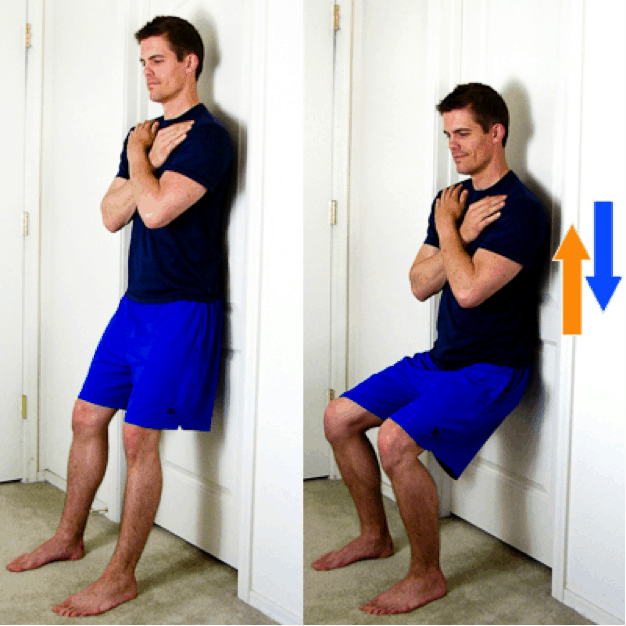
This move is more advanced, but great for the knees and other muscles as well.
- Keeping your feet on the floor, stand with your back against a flat surface, like a wall, with your feet shoulder width apart.
- Keeping your back and pelvis against the flat surface or the wall, slowly bend your knees
- Hold this position for 5-10 seconds.
- Do not bend too deeply and if you feel any pain, pressure, or discomfort in your knees, change your position.
- Repeat this exercise trying to hold the position a few seconds longer each time.
Step-Ups
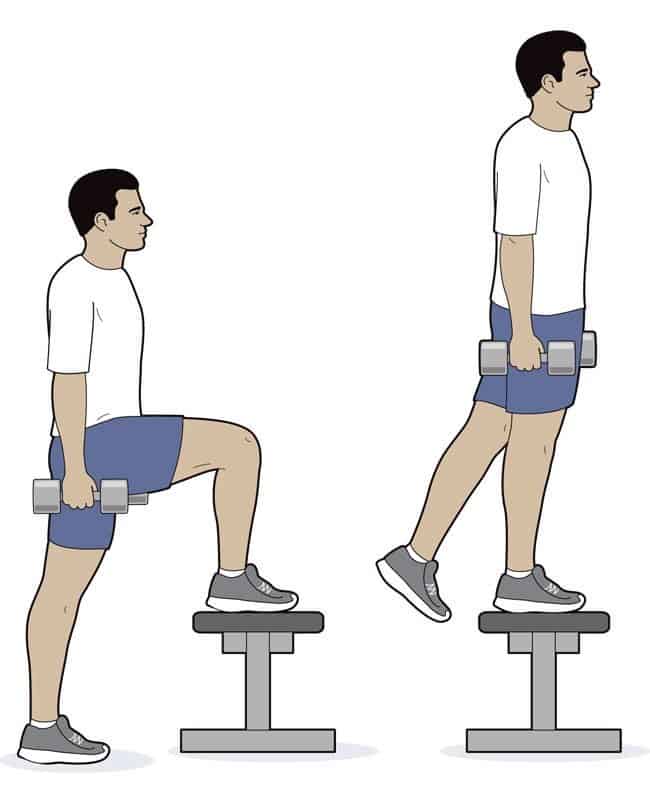
If you find this exercise to be too easy, use a higher step, or touch your heel instead of your toe.
- You will need a step bench, platform, or use the lowest step on a staircase.
- Bend your knee and slowly lower your other foot to the floor while keeping your pelvis level.
- Gently tap your toe to the floor, and then raise it back up.
- Repeat this exercise 10-15 times.
- Switch legs and repeat.
Taking the time to do these exercises or exercises similar will strengthen your knees and help to work your muscles. Feel free to do these exercises in your free time and several times a week, and even daily.

